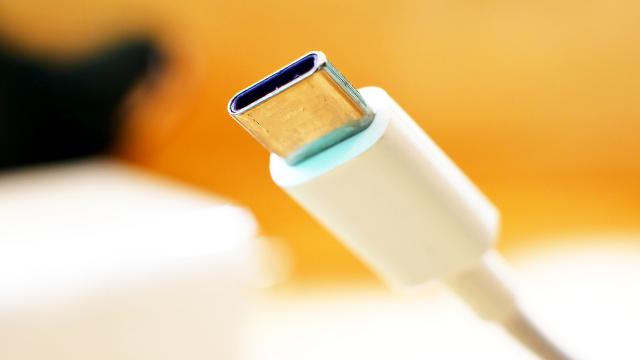This week there have been reports that Google will begin enforcing USB-PD compatibility for all new Android devices that utilise USB-C charging.
If you’re not sure what USB-PD actually is, we’ve got your back.
[referenced url=”https://gizmodo.com.au/2019/04/apple-enough-with-the-slow-ass-chargers/” thumb=”https://i.kinja-img.com/gawker-media/image/upload/t_ku-large/ou6bn64cttzk3cbgjrap.jpg” title=”Apple, Enough With The Slow-Arse Chargers” excerpt=”You may not know it, but your iPhone ” if an iPhone 8 or later ” is capable of much faster charging. The only problem is, Apple doesn’t give you the stuff necessary for it. But a new rumour claims that could be changing, and it should.”]
What is USB-PD?
You may have noticed that some phone manufacturer’s have their own proprietary fast charging technology. A good example of this is Oppo’s VOOC charging.
USB-PD (‘PD’ stands for ‘Power Delivery’) is a similar but far more universal standard that can fast-charge a variety of devices that use USB-C at 5V3A.
What is the USB-PD standard?
The PD system specs are rated up to 100 watts in order to accommodate larger devices such as monitors.
Smart phones, laptop and other small gadgets don’t require anywhere near this amount of power.
You may be wondering how this is going to work, especially when phone charging is messy enough on it own.
For example, the entry-level iPhone 11 still comes with a 5-watt charger, which is the same as what was on offer back in 2007. Fortunately the Pro and Pro max variants come with a beefier 18W charger. Of course, these utilise the lightening cable as opposed to USB-C.
Comparatively, the Samsung Galaxy S10 has a 15W charger and the Pixel 3XL comes in at 18W.
Then there’s fast charging. Oppo’s SuperVOOC charging offers up to 50W of power, Huawei’s SuperCharge for the P30 Pro has up to 40W and the Samsung Galaxy Note 10 has up to 45W.
That’s a lot of wildly different numbers to be floating around. USB-PD simplifies this.
It’s worth stating straight up that individual devices won’t be served up 100W of power regardless of what they are. That wouldn’t end well for many phones.
According to Android Authority, devices will fit into certain power categories (7.5W, >15W, >27W, and >45W) and will request the amount of power it can handle accordingly.
“Sources supplying more than 15 watts offer voltages of 5 and 9 volts, those supplying more than 27 watts offer 5, 9 and 15 volts, and those supplying more than 45 watts offer 5, 9, 15 and 20 volts. The maximum 100W power supply is achieved with 20V and up to 5A, although all of the other modes cap out at 3A, depending on the required power,” the website states.
So from the one charger your phone may request a mere 15W of power, where your laptop might request closer to 45W.
Why is this happening?
Having a universal standard for these chargers is useful as increasingly more devices other than just phones begin utilising USB-C.
For example, I’ll be able to charge my phone, laptop and headphones safely from the one charger.
It will also help to ensure speed consistency and regulation.
In addition to being convenient, it also has the potential to cut down on e-waste. Power standardisation means that there would no longer be a need for different chargers for each product in order to hit different ratings requirements.
What does this mean for future devices?
XDA Developers got its hands on a copy of version 7.0 of Google’s Google Mobile Services (GMS) requirements, which was published on September 3 2019.
This document outlines the requirements that Android devices need to meet in order to GMS.
A portion of the document stated, “New DEVICES launching from 2019 onwards, with a USB Type-C port MUST ensure full interoperability with chargers that are compliant with the USB specifications and have the USB Type-C plug.”
This language is far stronger than the previous version of the document which only ‘strongly recommended’ the compatibility.
This is important because failure to comply would mean an inability to these phones to contain any Google app, or services such as the Play Store.
We have seen the importance that GMS access holds over a device’s potential success in market recently with Huawei and its upcoming Mate 30. The prospect of the device not having access to Google apps will most likely tank sales for the device in markets such as Europe and Australia.
Still, Google is yet to make this announcement itself, and there are still some question marks around exactly what is meant by “full interoperability.”
However, it’s safe to assume that device manufacturer’s will take Google’s new requirement seriously and make their chargers compliant with USB-PD standards.
And this is great news, and not just from a speed perspective. Cutting down on cables is good for the environment and will make life easier for users.
